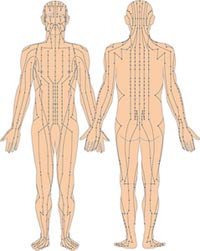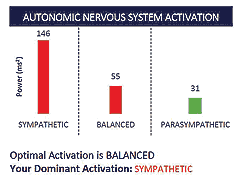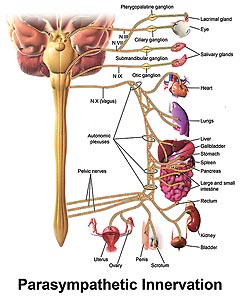|
|
HEALTHY HAPPENING September 2019
|
The Benefits of Acupressure
By Meagan Coy
|
As a massage therapist who practices Thai Massage, I have gained knowledge about acupressure through learning this bodywork modality. In Thai Massage, acupressure is used along what is called “Sen” lines, which are ten invisible energy lines that run throughout the body where a lot of major muscle attachments, nerve endings, internal organ correlation and blood circulation take place. These lines are very similar to Traditional Chinese Medicine (TCM) Meridian lines, where acupressure derives from. These lines tend to get “blockages” due to imbalances in the body such as organ dysfunction, muscle fatigue and build-up from negative, unprocessed emotions. Acupressure is used to work along these lines in order to restore balance to the entire body and help unblock anything that might be causing discomfort in your system. Since offering Thai Massage and applying acupressure work in my practice, it has been very well-received, so much so, that it has motivated me to incorporate it during my table massage sessions as well. But what is acupressure exactly? And why would you want to try it? That is what I hope to answer in the rest of this article.
When acupressure is applied to the body along those energetic lines that were mentioned earlier, finger pressure is used to mobilize chi, or “life force energy”, at specific spots on the body called acupoints. There are hundreds of acupoints on the body, corresponding to other parts of the body (for example, there’s a point on your hand for your kidney). These are physical points on the body and are the same points that are used in acupuncture, which is another healing modality derived from TCM that uses needles to help move the blocked chi in the body. Acupressure is often thought of as simply acupuncture without the needles, and both promote relaxation and wellness to help treat disease and bring unobstructed chi flow for optimal health. Acupressure can be applied by using fingers, palms, elbows or feet. Assisted stretching and special devices can also be used to apply pressure to acupoints on the body's meridians. In Thai Massage, the client is lying down on a mat on the floor and wearing comfortable loose clothing so that most, or all of these applications can be used in a session.
As with any form of massage, a huge perk of acupressure is relaxation, one that’s easy to get behind even if you doubt the existence of meridians. It is also often used for pain relief and stimulating the body's circulatory, lymphatic and hormonal systems. It also helps the function of the immune system and the body's natural ability to heal itself. Studies have also suggested it may help fight menstrual cramps, and headaches. Along with its ability to help treat a variety of ailments, receiver’s experience additional benefits such as:
• Relieving stress, tension and anxiety
• Improving sleep
• Relaxing muscles and joints
• Soothing the pain and discomfort of a sports or other injury
• Reducing digestive issues
• Alleviating chronic pain
According to the Acupuncture Massage College in Miami, Florida, most people notice a marked improvement in their symptoms following acupressure treatment, but some can feel worse before they start to feel better. Some of these side effects have been noted as:.jpg)
• Fatigue
• Soreness
• Bruising
• Muscle twitching
• Lightheadedness
• Emotional release
Although it’s hard to give yourself a full acupressure treatment without the help of a skilled practitioner, there are a lot of acupoints that you can apply pressure to yourself that can alleviate symptoms. Some of these are:
• ST 36: Find the bony point right under your kneecap, then move slightly outside the knee to find a small divot. That's Stomach 36, and it's used for indigestion, nausea, constipation, etc.
• LI 4: If you've ever applied pressure to the high point between your pointer finger and thumb, you were massaging Large Intestine 4, aka the "great eliminator." It's one of the most popular acupressure points for headaches and migraines. It's also thought to induce labor during pregnancy.
• GB 21: Gallbladder 21 is a well-known point used to relieve neck and shoulder tension from excess stress. It's located on the back side of either shoulder, between your neck and the point where your arm meets your shoulder.
• Yin Tang: If your yoga teacher has ever had you massage your "third eye" between your eyebrows, you were kneading the Yin Tang point. Mild pressure on the point is said to promote stress relief and relaxation.
• PC 6: Pericardium 6 is located on the inside of the wrist and is used for pregnancy-induced nausea or motion sickness. (It's the point that motion sickness bracelets press.)
The knowledge and use of acupressure has been around a long time in Eastern medicine and has been gaining popularity in the West over the last few decades. It is a modality that can help treat many ailments and has many benefits. If any of this information has resonated with you, I encourage you to give acupressure a try. Either through self-manipulation or finding a therapist who can apply it during a session for you.
Meagan Coy is a Licensed Massage Therapist and Registered Yoga Instructor. She is the owner of M.C.’s Healing Arts in Moab, Utah
|
What Happens In Vagus…
By Ray Andrew, MD
|
Every time I go to Vegas, I return with a wealth of lifesaving and lifechanging knowledge for my patients. This is because Vegas is where I attend one of many medical conferences each year. In this case, you definitely don’t want what happens in Vegas to stay in Vegas.
But what happens in Vagus doesn’t stay there, either. Originating in the brainstem, the Vagus Nerve sends and receives signals throughout the body. As the hub of the Parasympathetic Nervous System (PNS), it controls a lot: your heartbeat, blinking, breathing, blood vessels, liver and kidney function, digestion, glands (sweat, saliva, tears), pupils, sexual arousal, urination, immune function…
But there’s more: The Vagus Nerve controls inflammation. Acute inflammation is a good thing. It keeps us safe from invading bacteria and viruses, and is the first step in healing from injuries. Unfortunately, when we fail to turn off inflammation when it is no longer needed, serious damage occurs. Arthritis, asthma, cancer, heart disease, high blood pressure, high cholesterol, diabetes, Alzheimer’s, and chronic pain are all examples of inflammation gone awry. Whereas acute inflammation keeps us alive, chronic inflammation kills us slowly. This is why, in 2004, TIME Magazine called inflammation “the secret killer”.
Whenever I meet new patients for the first time, I am struck by how often I see the same list of drugs on their medication list: One for blood pressure, another for cholesterol, another for diabetes, and another for arthritis. In reality, this is not such a big surprise: All of these problems are just manifestations of inflammation in different body systems. Doctors are doing their best to treat the symptoms of inflammation but haven’t been taught to treat its causes.
What if…we could identify and treat the underlying cause of the inflammation? At Prestige Wellness Institute in Springville and Moab, we help people find those hidden sources of inflammation and assist their bodies in eliminating them. They are often found somewhere in the gut. They can be toxins; food sensitivities; or unwanted bugs in the teeth, stomach, or intestines. They can be found in foods. Sugar, for example, is highly inflammatory. So are glyphosate (Roundup) and other herbicides and pesticides. Preservatives are another important source. Our patients often find that chronic headaches, arthritis, or body aches go away when they clean up their diets.
But all too often, even when the trigger is gone, the body doesn’t know how to turn off the inflammatory fire that was so helpful at first. An infection might be long gone, but some of its symptoms may persist for months. You might have undergone surgery to fix an injury or correct a defect, only to find that the pain comes back, or doesn’t go away in the first place.
This is where the Vagus Nerve comes in. When activated, it releases neurotransmitters that tell white blood cells to calm down. Until white blood cells get this signal, they continue to release chemicals designed to destroy and remove bad bugs or damaged cells—even when the bugs or cells have already been removed.
It is for this reason that one of my professors, at a recent conference in Toronto, told me that it is impossible for the body to heal in a state of Sympathetic Nervous System (SNS) dominance. The white blood cells are simply too active for your own good.
This is partly why people end up needing more and more medicines over time. For example, some people have to take as many as four drugs for high blood pressure alone! Their bodies are in a constant state of fight or flight instead of reserving that response for times of actual danger.
Some people call the Parasympathetic Nervous System (PNS) the “rest and digest” system. This is partly true. It is actually the “rest, digest, and repair” system. In order to repair damaged tissues, we need a healthy Vagus Nerve.
Unfortunately, there is no pill you can pick up at the pharmacy to repair your Vagus. The treatment is actually much less expensive but more powerful than drugs. Start with your breathing. Most of us breathe in “fight or flight” mode: Shallow, and raising our chest wall. By contrast, “rest, digest, and repair” mode is activated by breathing deeply, slowly, and making your belly bulge out in front of you.
Next, when you eat, make sure you’re putting real food in your mouth. A good starting place is to avoid the aisles at the grocery store. Shop the perimeter instead. Even better, go organic. Then: Sit down and savor each bite, chewing slowly and completely. Take a break from loud, fast-paced music and listen to something that relaxes both your body and your mind. Meditate. Practice the Emotional Freedom Technique. Move. Remove the clutter from your home (especially from the bedroom), yard, and workspace. Learn to be slow to anger and quick to forgive (it’s not the offender who needs your forgiveness; it’s your Vagus Nerve that needs you to forgive). Laugh. Love people…even those you don’t like.
This is just a sampling of the actions you can undertake—for free and without a prescription—to increase your vagal tone, reduce inflammation, and promote healing.
If you need more assistance in this process, make an appointment (435-259-4008) to see us at Prestige Wellness Institute in Springville or Moab. We can also show you if your PNS and SNS are operating in balance. A simple test can help you see whether your efforts to strengthen your parasympathetic tone are paying off. If not, we can help you with additional tools to bring balance to this critical system. Don’t blow it off. What happens in Vagus…can change your life.
|
| |
|
|
|
|
|
|
© 2002-2024 Moab Happenings. All rights
reserved.
Reproduction of information contained in this site is
expressly prohibited.
|
|